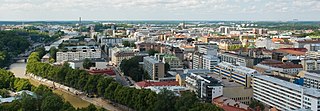
Turku is a city and former capital on the southwest coast of Finland at the mouth of the Aura River, in the region of Finland Proper (Varsinais-Suomi) and the former Turku and Pori Province. The region was originally called Suomi (Finland), which later became the name for the whole country. As of 31 March 2021, the population of Turku was 194,244 making it the sixth largest city in Finland after Helsinki, Espoo, Tampere, Vantaa and Oulu. There were 281,108 inhabitants living in the Turku Central Locality, ranking it as the third largest urban area in Finland after the Capital Region area and Tampere Central Locality. The city is officially bilingual as 5.5 percent of its population identify Swedish as a mother tongue.

Åbo Akademi University is the only exclusively Swedish language multi-faculty university in Finland. It is located mainly in Turku but has also activities in Vaasa. Åbo Akademi should not be confused with the Royal Academy of Åbo, which was founded in 1640, but moved to Helsinki after the Turku fire of 1827 and is today known as the University of Helsinki.

The University of Turku, located in Turku in southwestern Finland, is the third largest university in the country as measured by student enrollment, after the University of Helsinki and Tampere University. It is a multidisciplinary university with eight faculties. It was established in 1920 and also has facilities at Rauma, Pori, Kevo and Seili. The university is a member of the Coimbra Group and the European Campus of City-Universities (EC2U).
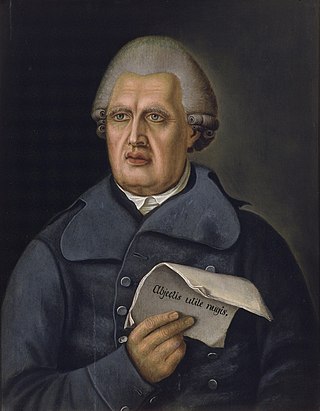
Henrik Gabriel Porthan was a professor and rector at the Royal Academy of Turku. He was a scholar sometimes known as The Father of Finnish History.

Robert Kajanus was a Finnish conductor, composer, and teacher. In 1882, he founded the Helsinki Orchestral Society, Finland's first professional orchestra. As a conductor, he was also a notable champion and interpreter of the music of Jean Sibelius.
Lilius is a surname. Notable people with the surname include:
Kimmo Nevonmaa was a Finnish composer of contemporary music. Graduating from Kuopio Conservatory as a teacher of music theory in 1988, he continued his composition studies in Sibelius Academy.

Martin Wegelius was a Finnish composer and musicologist, primarily remembered as the founder, in 1882, of the Helsinki Music Institute, now known as the Sibelius Academy.
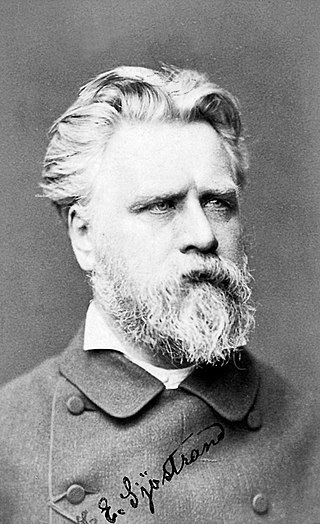
Carl Eneas Sjöstrand was a Swedish sculptor who worked for over 40 years in the Grand Duchy of Finland.
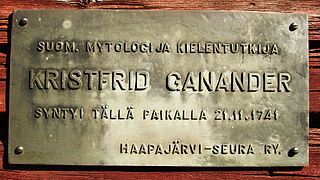
Cristfried Ganander was a Finnish compiler of folk culture, a priest and an 18th-century lexicographer. Ganander's greatest achievement was the compilation of the first fully extensive Finnish-language dictionary which was, however, unpublished. He was also a collector of folk culture well before Elias Lönnrot. His most well-known published work is Mythologia Fennica in 1789, a reference book of folk religion. He also published some poetry and worked as a teacher.
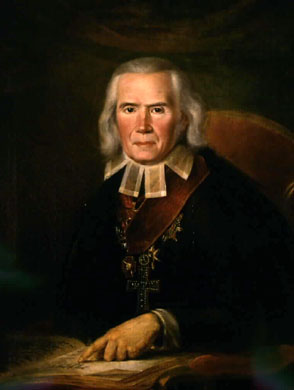
Jacob Tengström was a Finnish prelate who became the first Archbishop of Turku and Finland.

Björkudden is a manor house in Östersundom, Helsinki, Finland, designed by the architect Wilhelm Linsén and built in the mid-19th century. Koivuniemi was the home of the Finnish writer and historian Zacharias Topelius. After his death it returned to the previous owners and is to the present owned by the Lilius family.
Johan Lilius (1724–1803) was a Finnish justice of the Hovrätt in Åbo, at a time when this court was part of the judicial system of Sweden, and a founding member of the Aurora Society.
Siv Elisabeth Margaretha Wärnfeldt is a Swedish author, opera and concert singer.

Svenska fruntimmersskolan i Åbo or only Svenska fruntimmersskolan was a Girls' School in Turku in Finland, active from 1844 to 1955. Alongside its equivalent in Helsinki, Svenska fruntimmersskolan i Helsingfors (1844-1974), it was the first state school for females in Finland. From 1919, it was called Svenska flickskolan i Åbo.

Synty is an important concept in Finnish mythology. Syntysanat ('origin-words') or syntyloitsut ('origin-charms') provide an explanatory, mythical account of the origin of a phenomenon, material, or species, and were an important part of traditional Finno-Karelian culture, particularly in healing rituals. Although much in the Finnish traditional charms is paralleled elsewhere, 'the role of aetiological and cosmogonic myths' in Finnic tradition 'appears exceptional in Eurasia'. The major study remains that by Kaarle Krohn, published in 1917.
SHIFT is a two-day international business festival held every year in Turku, Finland, at the Turku Castle. It was first held on May 31 and June 1, 2016. The attendees included over 1,000 visitors, 80 partner companies, 150 startups, and over 20 investors. Around 100 volunteers were part of this event. SHIFT 2017 is slated to be held on May 31 and June 1, 2017.
Finnish national symbols are natural symbols or Finnish national works and prominent figures that are commonly associated with Finland. The most recognized national symbols include the flag of Finland and the lion featured on the Finnish coat of arms.
Elisabet Wittfooth née Tottie was a Finnish merchant and shipowner.
Kaino Tuovi Lemmikki Kekomäki was a Finnish lawyer who was elected as the first woman to become a member of the Supreme Administrative Court in 1956.












